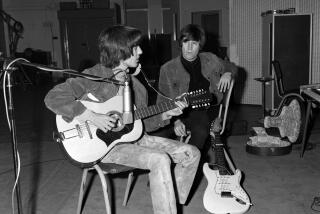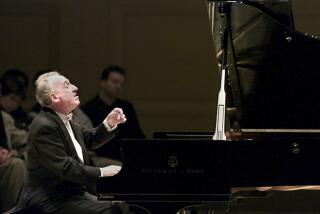Swedish researchers try to unlock Stradivari’s secrets
- Share via
Paganini had two of them. Heifetz owned “Dolphin,” perhaps the best of the best. Itzhak Perlman bought “Soil” from Yehudi Menuhin for $1.25 million and probably got a bargain. Christie’s sold “Lady Tennant” at public auction last year for $2 million, and private owners have gotten more than twice as much in closed deals.
Nearly 270 years after his death, the genius of violin-maker Antonio Stradivari shines as brightly as ever. So elegant do his violins sound, so easily do they play and so beautiful are they to behold that most of the 650 or so that survive are famous enough to have their own names.
Even as the music from Stradivari’s instruments has captivated generations of concertgoers, their workmanship has confounded generations of scientists and artisans. Why does a Stradivarius sound the way it does? Why has no one been able to duplicate it?
Over the years, experts in disciplines ranging from carpentry to historical climatology have explored the phenomenon, bringing provocative insights to the debate but finding no definitive model that a craftsman could take to the workshop.
Into this quest a Swedish team has suggested something different: Instead of trying to build a duplicate Stradivarius part by part, why not start with a computer model of a whole violin, tinker with it electronically until its sound matches a Stradivarius -- and then build it?
“The violin is easy to measure geometrically,” said structural engineer Mats Tinnsten in a telephone interview from Mid Sweden University. “Then you can measure how it vibrates, look at the frequencies and other parameters. You excite it with a loudspeaker, knock on it.... We can do this as well.”
But after that it gets tricky. Violins are made of wood, and no two pieces of wood are exactly alike. Each violin, whether built by Stradivari or Tinnsten, is unique, and the challenge is to sculpt the wood -- delicately shaving the top and the back -- to “optimize” the acoustical qualities. Stradivari, working in a pre-industrial age, did this by ear and hand with unsurpassed consistency and artistry.
Tinnsten said his team can do it too. “Violin makers reduce the thickness of the wood with a knife, and do it in different places until they are satisfied,” he said. “We use the same method, but in the computer. We take an electronic blank and carve it.”
The Swedish team’s next task is to prove that its program works. It proposed building a violin with two tops. Carve one top, install it, and measure and calibrate the sound of the resulting instrument. Then load these parameters into the computer and carve a different piece of wood so as to duplicate the sound produced by the first.
This project is not yet underway, Tinnsten said, “but all we lack is time.” Only if the two-tops experiment succeeds will the team ask for the privilege of measuring and, perhaps, duplicating an actual Stradivarius.
The Swedish research, first presented last summer at the International Congress on Sound and Vibration, offers a new and welcome wrinkle on the Stradivari puzzle, said violin expert Thomas Sparks, director of string instrument technology at Indiana University’s Jacobs School of Music. But acoustics isn’t the whole story, he added. “It’s about the whole box.”
Stradivari, better known by the Latinized version of his name, Stradivarius, learned his trade from the Amati family of Cremona, near Milan. Beginning with the Amatis, continuing with Stradivari and finishing with Giuseppe Guarneri del Gesu, the Cremonese instrument makers dominated the violin trade from around 1560 to 1750.
The Amatis, Sparks said, “knew how to teach violin making,” while Guarneri was a tinkerer and a genius “who made a dozen violins that could outplay any Strad,” but he couldn’t manage it regularly.
Stradivari, who was born in 1644 and died in 1737, “is the most consistent artist, with good sound, good looks and good coloration,” Sparks said. “Stradivari could consciously alter an instrument to obtain a desired result. I believe if you knocked on his door today, he could tell you exactly how he did it.”
But no one else can. Early in the post-Cremona world, craftsmen tried without success to duplicate the Stradivari sound by building violins to the master’s exact dimensions. In the 19th century, restorers strengthened the Stradivari instruments by enlarging the bass bars and sound posts. The violins sounded even better, but still, nobody could clone them.
More recently research has focused on the wood -- soft spruce on the top plate and hardwood maple on the back plate and sides. The spruce vibrates, while the maple propels the sound up and out. The effect is like that of a kettledrum.
The key, some scientists have suggested, is that Stradivari used alpine spruce during a climatic era of uncommonly cold weather. Annual growth rings were close together, making the wood abnormally dense. Others have focused on the varnish, suggesting it stiffened the wood.
Sparks, a violin maker in his own right and an expert on the Cremona craftsmen, has noted that the woods Stradivari used were almost devoid of sugars, saps, resins and other organics, leaving only fibers and lignin, the “glue” that holds the fibers together.
“Think of it as similar to mummification,” Sparks said. “Added weight retards sound, so you want the structure to be lightweight with high fiber density, and these older instruments are 20% lighter than modern wood -- and it’s not because of age.”
If a special curing process is the answer, the Swedish experiment could be doomed, because the raw material will require an as-yet-unknown pretreatment. If curing is not the answer, though, then Sweden, with plenty of cold-weather trees, “should be able to produce a pretty good violin,” Tinnsten said.
Prospects for resolving the mystery should improve because a lot of people are working on it, and “there isn’t anything hidden,” Sparks said. But, he added, it will take time, because “you can’t find all the information in one spot.”
When the Italian economy nosedived in the late 18th century, the Cremonese violin makers went out of business, Sparks explained. Craft guild records and family histories were squirreled away in multiple archives, confounding the efforts of both violin makers and scientists to unearth them.
“At this point,” Sparks said, “the search is like archeology.”
More to Read
The biggest entertainment stories
Get our big stories about Hollywood, film, television, music, arts, culture and more right in your inbox as soon as they publish.
You may occasionally receive promotional content from the Los Angeles Times.










